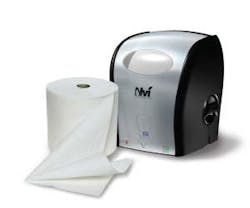Managing Greener Buildings
All things being equal, facility managers and building owners like to choose products that will enhance their facilities, satisfy their tenants and help the environment. But these days sustainable purchasing isn’t as simple as a recycling or certification logo, and new innovations serve to grow and stretch a shared vision of sustainability. Each year building managers and owners find themselves with an array of new products, all of which promise to make their facilities “greener.” Take the green paper and tissue products that are used in building restrooms. Are all these products created equal? Not really.
Recycling: Helpful, But Not Leading Edge
In the 1990’s, recycling became popular. In fact, if a facility manager or building owner wanted to help the environment in those days, using paper, tissue and towels made from recycled paper was usually your only option. Because of this, the easiest way to measure “green-ness” was through a product’s percentage of recycled content.
By today’s standards, the process of recycling is a very energy-intensive, inefficient way for your building to “go green.” For example, when paper is recycled in the United States, about a third of it is sent to China, usually to become boxes for toys and other consumer products. The paper needs to be picked up by the disposal company, processed and cut, bundled for shipping, delivered to port, taken by ship to China, taken by train to a paper mill, treated with chemicals to de-ink, reshaped into a new product and returned through the same routes back to the United States to be used all over again. That is a lot of work––and energy––for something that claims to be good for the environment. This is particularly cumbersome given that, even with new recycling technology, tenants often still prefer to use paper and tissue products that aren’t made from recycled paper.
Green Begins Before Recycling
Today’s newest innovations are making recycled content a very “old-school” approach to sustainability. Recent sustainability science is revolutionizing the paper and tissue industry by utilizing fiber harvesting techniques that are redefining the notion of “green” for building management. Modern tree plantations near the equator are revealing that paper can be sustainable without recycling, when it’s made with fibers from rapidly renewable trees. Rapidly renewable trees are trees that grow so fast they can reach full height quickly––more like crops than our image of conventional slow-growing forests. These plantation-grown trees can grow to maturity in as little as six years.
The Young Tree Advantage
These new, plantation-grown trees are being grown on tree farms that are fully compliant with national laws. In fact, many go beyond the laws with sustainability standards that are internationally certified from seed to paper. Neutral, third-party organizations monitor the plantation practices and pulpwood handling to verify that sustainable forest management practices are followed.
This article is advertiser sponsored:
Equally important to the environment, these fast-growing trees leave no “holes” in the forest like they do in a colder, northern climate. Trees are organized to grow and be harvested in ways that maintain the landscape and keep a constant environment for local animals. In contrast, most recycled paper in the United States originally came from old-growth forests. Old-growth forests are full of trees that have been around for decades, or even centuries. These trees absorb tons of greenhouse gases over the years and are home to plant and animal life.
Evolving to a Brighter Shade of Green
Building managers and owners who are looking for better sustainability in their buildings’ restrooms now have a growing set of options. Not only are there paper and tissue products that utilize this young, greener fiber, there are also new technologies to dispense this paper in a more environmentally progressive way. Electronic hand towel dispensers provide greener, more sanitary, automatic dispensing that eliminates paper waste and added costs. And now this automatic technology is being put to use in the first standard-sized, automatic dispenser for toilet tissue.
Today, property management professionals and building owners have more options than ever to make their facilities greener, more sustainable and more inviting to building tenants while increasing their LEED credits at the same time. From rapidly renewable fiber to new automated technology, there is no excuse for building managers not to go green.
Don Totten is vice president of marketing for Oasis Brands’ Away-from-Home business.
